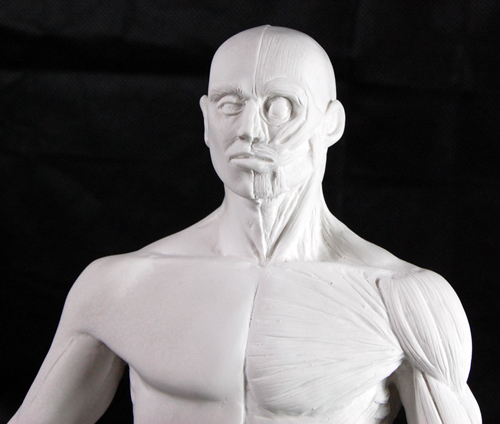Ecor… what? Écorché!
The classical ateliers also offer – besides drawing and painting classes – sculpting classes where you are taught anatomy either with an écorché figure or a nude figure (see here their Facebook photos with lots of sculpures!).
Écorché simply means flaying/skinning. An écorché figure is a sculpture where the bones and muscles are visible. Here I’ve already talked about some anatomy learning apps for your smart device.
Drawings and paintings are two dimensional representations of a three dimensional reference. Beeing able to make this transfer from three dimensions to a flat surface is the skill you are aiming for in becoming a painter. That’s why you do cast drawings and – in the best case – figure drawings as a preparation for going into colors.
I’ve already shown you how to make your own – and very inexpensive – plaster casts, but now I’m going to talk about how you can make your own reference sculpture without having to buy a large italian marble block and chissels. What you will learn is a three dimensional understanding of form (and patience!). That’s why the painting academies also teach sculpting.
How to start
Today’s materials are superior to those used by the old sculptors – like marble or clay. Marble allows no errors and clay would dry out too fast for a novice sculptor and it has to be baked at temperatures much higher than a regular kitchen oven.
Super Sculpey* is an oven curing synthetic clay which you can knead just like putty. After you are finished with your work, you can bake it in the oven so that it gets hard enough for finer improvements like carving details or sanding to a super smooth surface.
After having watched some Youtube videos (see the videos at the end of this post) I started to make a wire skeleton first and then built up an écorché figure.
Now comes the part where the story gets a little complicated for you as a reader but in brief: I made an écorché figure with Super Sculpey. Baked it, made a silicone mold, the figure broke and it looked awful, I made a new figure which is larger.

1. first figure in Super Sculpey with broken arm
2. first cast with broken hands
3. second figure in Super Sculpey with broken leg
4. perfect cast with Artestone
Super Sculpey has a skin color but in case you’d like to work with a grey clay like I did you can either do it by mixing one part of black FIMO* with 20 parts of Super Sculpey* or you can use Super Sculpey Firm*.
So here are the process pictures of my Super Sculpey 1:6 ecorché figure with skin on its right left side and skinned on its left side:

And this is how it turned out after one week of pure sculpture work and one week for molding/casting:

You would like to start now?
Here are the videos I watched prior to my project. Julian Khor’s channel has many many many videos, showing start to finish. You’ll learn a lot about anatomy, since Julian is building his figures from the bones up to every muscle.
Super Sculpey Ecorche Figurine Sculpting-Part 02/34
Unfortunately there is no Part 1 – but here is part one of Julian’s Hercules Ecorche figure:
Go to Julian’s video channel on YouTube: click here
Clay Écorché in 5 minutes:
*Affiliate links







So impressed with your dedication… Although I don’t think I will be casting my own face any time soon, LOL. Shows you will stop at nothing. Great site. I have been looking everywhere for select pages of the Munsell YR and R and Yellow charts for skin tones. As well as that huge Munsell full color chart. Thank you for posting. I do feel, when looking at some of the artists who are using Munsell as a guide (and some of them are top notch) that they are missing the point in a way. You are supposed to lay out the strings and mix to the model. Hold the painting knife up to the model and lay it in. Reilly did this piece by piece. You do have the one kind of local complexion string, but there is tons of mixing to lay in on top of that for each area. So the complexion string is just a start. The process is more fluid, more artistic, not as scientific as some make it seem. Marvin Mattelson is a very good example of how it is done, even though he uses a different red and yellow (using Paxton palette), Jeffrey Watts from Watts Atelier also is a direct descendent of Reilly and has the system done correctly (using Zorn palette). Jack Faragasso at Art Students League is using pure Reilly.
Hello Julia.
Thank you for your comment (which actually should belong to my blog post about color charts http://www.classicalatelierathome.com/save-hundreds-on-studio-equipment).
You are right, some are approaching color in a scientific manner which can make things more complicated or intimidates young artists.